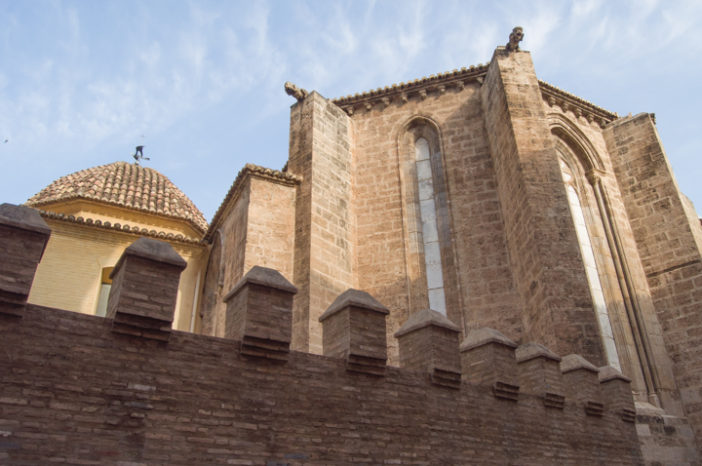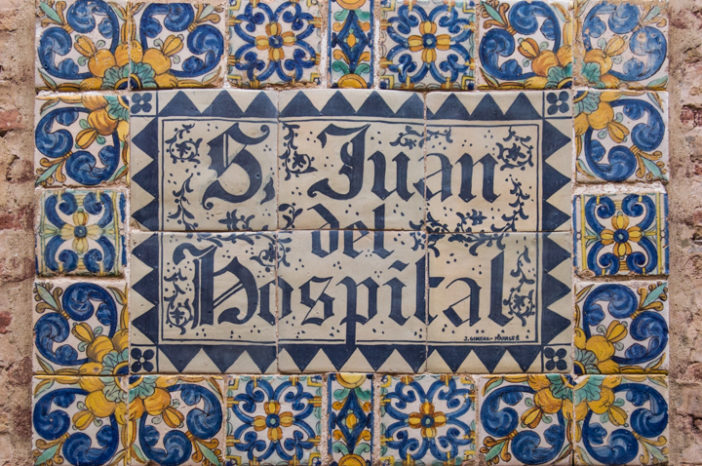Temple of Sant Joan del Hospital
The Temple of San Juan del Hospital, in Valencia, built between the years one thousand two hundred and thirty-eight and one thousand two hundred and sixty-one, as extreme dates, was the first Christian Hospital-Church in the city, recently won by King Don Jaime and headquarters of the Order of San Juan.
The Church, of Cistercian type, has the characteristic Valencian seal; and it is not sumptuousness or artistic exquisiteness that gives extraordinary importance to the Monument, but its very sobriety, circumstantial with its venerable archaism. Of the rest of the Convent (completed before one thousand three hundred and sixteen), it is very unostensible, but it has as much interest and the same merits as the Church, to take care of its conservation.
The Hospital complex of San Juan del Hospital is located in a block bordered by Trinquet de Cavallers, Miracle and Carrer del Mar. It is a milestone in the city of Valencia, not only because it was the first consecrated church (after the Cathedral) after the conquest of Valencia in 1238, which makes it the oldest church in the city, but because it is part of the citizen’s history and belongs, therefore, to the historical memory.
We can assure you that different cultures converge within its walls:
The thorn of the Roman circus crosses the South Courtyard and the esplanade that surrounds it served as a base for the construction of Visigothic and later Muslim dwellings, has Romanesque, Gothic and Baroque vestiges
The hospital complex consisted of a church, a hospital and a cemetery. The church and remains of the cemetery are preserved.
It is accessed through Trinquet Cavallers street through a vestibule in which are painted the crosses of the crusaders of the thirteenth century. Also in this first space is the chapel of the Virgin of the Miracle.
After this space we go to a patio decorated with ceramic altarpieces representing the Via Crucis. On the left is the side doorway of the church with a semicircular arch with alfiz and at the top a pointed Gothic window with tracery representing the Maltese cross.
To the right of the courtyard are remains of other buildings such as arches of the old hospital and new outbuildings.
The current access to the church is through the feet through two small rooms, one of them as an atrium and another next covered with a crossing vault that leads to the church.
It is a single-nave temple with chapels between buttresses, with a polygonal presbytery with stylized windows covered with a ribbed vault. The nave is covered with a pointed barrel vault with stone plementery divided with fajone arches.
The side chapels on the gospel side are covered with rib vaults, while those on the gospel side have a pointed barrel vault.
After the third chapels are the doors, and after these other side chapels, the smaller one on the left and the one on the right is the chapel of Santa Barbara where the tomb of Doña Constanza de Entenza is located.
It has a Greek cross floor plan covered with a galloned dome on four shells, in the center and on the arms of the cross barrel walled vaults. The decoration is based on reliefs made of plaster with floral motifs, posters and sgraffito. On the chamfered pillars of the corners are niches with archangels and the guardian angel of the kingdom.
At the foot of the church, on the side of the gospel, is the chapel of the Virgin of the Students.
To the south of the church are the remains of the hospital cemetery. Next to the cemetery, towards the church, is the so-called chapel of Jaume I or funeral chapel. It consists of a square section open on its sides and an ochavada headboard covered with a crossing vault with tile plementos arranged in thread.
The church is Gothic in style, although with Romanesque traditions. In the seventeenth century it was renovated and expanded its factory with the chapel of Santa Barbara, it seems that the works lasted until the eighteenth century since in the key appears the inscription "was renovated in 1726". Above the north doorway was the medieval bell tower that was replaced by a new one in the eighteenth century with classical trace. In the nineteenth century, after the confiscation, it ceased to belong to the order to become a parish church. In 1905, the church of Sant Joan i Sant Vicent was built in the expansion, to which the parish church of Sant Joan del Hospital and most of its movable property passed.
Funeral Chapel
The Funeral Chapel, built in the thirteenth century, is located in the South Courtyard, next to the medieval cemetery, a unique example today of this architectural typology. This funeral hospital chapel is also known as the Chapel of King James I.
It is a chapel formed by two sections, the first of which has a square floor plan covered by a crossing vault and open on three of its sides and the second section formed by an ochavated head as an apse.


Dades bàsiques
Calle Trinquet de Cavallers, 5
46003 Valencia